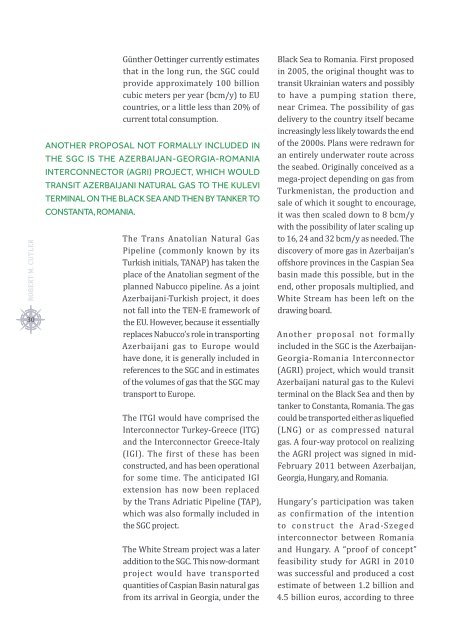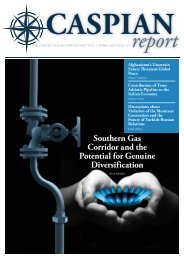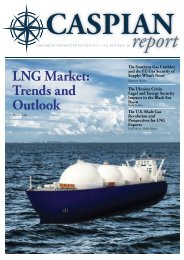Caspian Report - Issue 06 - Winter 2014
Create successful ePaper yourself
Turn your PDF publications into a flip-book with our unique Google optimized e-Paper software.
ROBERT M. CUTLER<br />
30<br />
Günther Oettinger currently estimates<br />
that in the long run, the SGC could<br />
provide approximately 100 billion<br />
cubic meters per year (bcm/y) to EU<br />
countries, or a little less than 20% of<br />
current total consumption.<br />
ANOTHER PROPOSAL NOT FORMALLY INCLUDED IN<br />
THE SGC IS THE AZERBAIJAN-GEORGIA-ROMANIA<br />
INTERCONNECTOR (AGRI) PROJECT, WHICH WOULD<br />
TRANSIT AZERBAIJANI NATURAL GAS TO THE KULEVI<br />
TERMINAL ON THE BLACK SEA AND THEN BY TANKER TO<br />
CONSTANTA, ROMANIA.<br />
The Trans Anatolian Natural Gas<br />
Pipeline (commonly known by its<br />
Turkish initials, TANAP) has taken the<br />
place of the Anatolian segment of the<br />
planned Nabucco pipeline. As a joint<br />
Azerbaijani-Turkish project, it does<br />
not fall into the TEN-E framework of<br />
the EU. However, because it essentially<br />
replaces Nabucco’s role in transporting<br />
Azerbaijani gas to Europe would<br />
have done, it is generally included in<br />
references to the SGC and in estimates<br />
of the volumes of gas that the SGC may<br />
transport to Europe.<br />
The ITGI would have comprised the<br />
Interconnector Turkey-Greece (ITG)<br />
and the Interconnector Greece-Italy<br />
(IGI). The first of these has been<br />
constructed, and has been operational<br />
for some time. The anticipated IGI<br />
extension has now been replaced<br />
by the Trans Adriatic Pipeline (TAP),<br />
which was also formally included in<br />
the SGC project.<br />
The White Stream project was a later<br />
addition to the SGC. This now-dormant<br />
project would have transported<br />
quantities of <strong>Caspian</strong> Basin natural gas<br />
from its arrival in Georgia, under the<br />
Black Sea to Romania. First proposed<br />
in 2005, the original thought was to<br />
transit Ukrainian waters and possibly<br />
to have a pumping station there,<br />
near Crimea. The possibility of gas<br />
delivery to the country itself became<br />
increasingly less likely towards the end<br />
of the 2000s. Plans were redrawn for<br />
an entirely underwater route across<br />
the seabed. Originally conceived as a<br />
mega-project depending on gas from<br />
Turkmenistan, the production and<br />
sale of which it sought to encourage,<br />
it was then scaled down to 8 bcm/y<br />
with the possibility of later scaling up<br />
to 16, 24 and 32 bcm/y as needed. The<br />
discovery of more gas in Azerbaijan’s<br />
offshore provinces in the <strong>Caspian</strong> Sea<br />
basin made this possible, but in the<br />
end, other proposals multiplied, and<br />
White Stream has been left on the<br />
drawing board.<br />
Another proposal not formally<br />
included in the SGC is the Azerbaijan-<br />
Georgia-Romania Interconnector<br />
(AGRI) project, which would transit<br />
Azerbaijani natural gas to the Kulevi<br />
terminal on the Black Sea and then by<br />
tanker to Constanta, Romania. The gas<br />
could be transported either as liquefied<br />
(LNG) or as compressed natural<br />
gas. A four-way protocol on realizing<br />
the AGRI project was signed in mid-<br />
February 2011 between Azerbaijan,<br />
Georgia, Hungary, and Romania.<br />
Hungary’s participation was taken<br />
as confirmation of the intention<br />
to construct the Arad-Szeged<br />
interconnector between Romania<br />
and Hungary. A “proof of concept”<br />
feasibility study for AGRI in 2010<br />
was successful and produced a cost<br />
estimate of between 1.2 billion and<br />
4.5 billion euros, according to three










